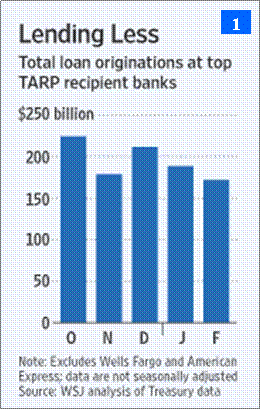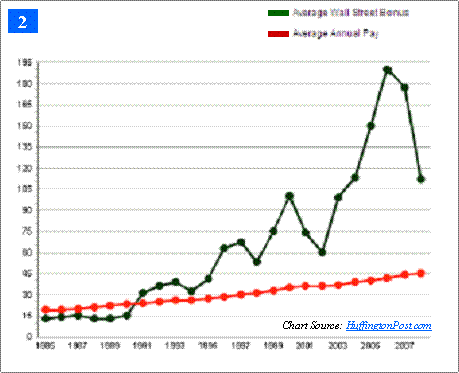More Bonus Plus Less Lending Equals The March on Wall Street
Politics / Credit Crisis 2010 May 02, 2010 - 06:29 AM GMTBy: Static_Chaos
 According to a Wall Street Journal analysis of Treasury Department data, the biggest recipients of taxpayer aid made or refinanced 23% less in new loans in February, the latest available data, than in October, the month the Treasury kicked off the Troubled Asset Relief Program (TARP). (Chart 1)
According to a Wall Street Journal analysis of Treasury Department data, the biggest recipients of taxpayer aid made or refinanced 23% less in new loans in February, the latest available data, than in October, the month the Treasury kicked off the Troubled Asset Relief Program (TARP). (Chart 1)
 Excluding mortgage refinancings, consumer lending dropped by about one-third between October and February. Commercial lending slumped by about 40% over that period, the data indicates. All but three of the 19 largest TARP recipients originated fewer loans in February than they did at the time they received federal infusions.
Excluding mortgage refinancings, consumer lending dropped by about one-third between October and February. Commercial lending slumped by about 40% over that period, the data indicates. All but three of the 19 largest TARP recipients originated fewer loans in February than they did at the time they received federal infusions.
Meanwhile, the average Wall Street bonus soared almost 14 times higher (by 2006); the average worker's salary has essentially been stagnant sine the mid-1980s. (Chart 2)
Wall Street bonuses paid to New York City securities industry employees rose by 17% to $20.3 billion in 2009, according to an estimate released in February by State Comptroller Thomas P. DiNapoli. (Click here for a chart showing bonuses paid from 1985-2009.)
According to an estimate by New York State Comptroller Thomas P. DiNapoli, Wall Street bonuses paid to New York City securities industry employees rose by 17% $20.3 billion in 2009. This is a chart showing bonuses paid from 1985-2009.
Total compensation at the largest securities firms grew even faster and industry profits could exceed an unprecedented $55 billion in 2009, nearly three times greater than the previous all-time record. In 2008, the industry lost a record $42.6 billion.

Basically, after unloading their toxic assets onto the Fed / taxpayers' balance sheet, Wall Street is able to increase bonus partly through less lending, because with the free money from the government, banks have discovered that lending to businesses and consumers does not give them as high returns as other activities such as juicing up stock markets and commodities.
A 17% bonus increase in a recession year with a nationwide jobless rate of around 10%, coupled with a reduction in lending while receving TARP money - a sure fire recipe for becoming public enemy number 1.
So, no surprise here -- a video from WSJ.com dated Apr. 30 showing thousands of demonstrators rallied against big banks in New York's financial district, calling for accountability and job creation. Wonder if Goldman Sachs employees are still packing guns?
By Static Chaos
http://static-chaos.blogspot.com
© 2010 Copyright Statoc Chaos- All Rights Reserved
Disclaimer: The above is a matter of opinion provided for general information purposes only and is not intended as investment advice. Information and analysis above are derived from sources and utilising methods believed to be reliable, but we cannot accept responsibility for any losses you may incur as a result of this analysis. Individuals should consult with their personal financial advisors.
© 2005-2022 http://www.MarketOracle.co.uk - The Market Oracle is a FREE Daily Financial Markets Analysis & Forecasting online publication.



